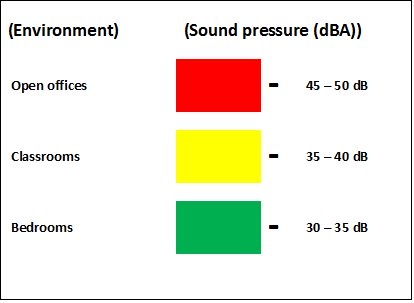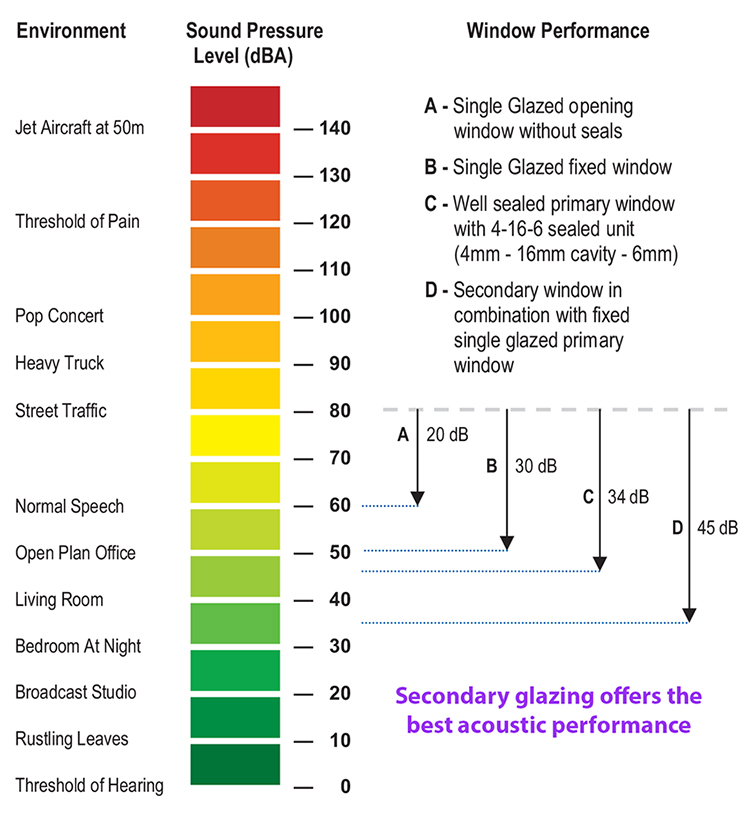The weakest barrier to noise ingress in most buildings is their windows. As a result of new legislations pertaining to acoustic performance, Selectaglaze is receiving a growing number of requests from the education sector. The majority of these projects are retrofits of existing classrooms.
The Building Bulletin 93 outlines the acoustic performance required of school buildings. Over the decades preceding this legislation educational research had proven a direct correlation between poor acoustics and poor academic outcomes. Research also revealed that children with any degree of special need where especially negatively affected. In addition studies showed poor acoustic performance in classrooms had a detrimental effect on the health of teachers and teaching assistants.
 WHO Acoustic levels per room type
Fixing acoustic performance retrospectively in a new build, results in disruption which in turn can have a negative impact on academic outcomes. To address this issue standards and the Building Bulletin 93 were drawn up to assist both the designers and educational estates in achieving new schools that were acoustically fit for purpose from the outset. WHO, the (World Health Organisation) recommendation for acceptable noise ingress through a classroom window is 40dB maximum.
Twelve years on the Building Bulletin 93 (Update 19th December 2016), has been extended to cover both change of use and retrofit educational projects. These regulations apply to all older school properties undergoing refurbishment as well as change of use projects. These regulations allow for a degree of flexibility in both design and performance as they recognise that pre-existing schools may also have to adhere to additional planning restrictions.
In addition to controlling the acoustic performance of the actual school building and its structure the designer needs to also pay attention to each individual room’s acoustics. The size, shape, layout and acoustic absorption properties of the interior all need to be carefully configured for each room type. Teaching rooms should facilitate communication in a normal speaking voice i.e. A sound power output of 10 microwatts. Speaking at this volume allows for intonation and expression which help communicate meaning. In order for a teacher to be heard at normal speech levels ambient sounds must be kept at a minimum.
WHO Acoustic levels per room type
Fixing acoustic performance retrospectively in a new build, results in disruption which in turn can have a negative impact on academic outcomes. To address this issue standards and the Building Bulletin 93 were drawn up to assist both the designers and educational estates in achieving new schools that were acoustically fit for purpose from the outset. WHO, the (World Health Organisation) recommendation for acceptable noise ingress through a classroom window is 40dB maximum.
Twelve years on the Building Bulletin 93 (Update 19th December 2016), has been extended to cover both change of use and retrofit educational projects. These regulations apply to all older school properties undergoing refurbishment as well as change of use projects. These regulations allow for a degree of flexibility in both design and performance as they recognise that pre-existing schools may also have to adhere to additional planning restrictions.
In addition to controlling the acoustic performance of the actual school building and its structure the designer needs to also pay attention to each individual room’s acoustics. The size, shape, layout and acoustic absorption properties of the interior all need to be carefully configured for each room type. Teaching rooms should facilitate communication in a normal speaking voice i.e. A sound power output of 10 microwatts. Speaking at this volume allows for intonation and expression which help communicate meaning. In order for a teacher to be heard at normal speech levels ambient sounds must be kept at a minimum.
 Environment and window performance
As many schools are located in cities and towns the acoustic performance of a room cannot been assessed in isolation. The level of noise ingress to which the room is subjected to throughout the day must also be measured and meet the required standards. In order to achieve the 40dB threshold figure within schools located in highly populated areas, attention needs to be paid to noise ingress.
Existing single pane primary windows with a performance as low as -20dB are not fit for purpose in buildings located next to busy roads where ambient noise levels can range between 75 – 95dB. Often such localities are also subject to the additional nuisance and distraction of aeroplanes flying overhead.
As well as providing a more effective sound barrier than double glazing, secondary glazing is the only generally accepted glazing solution for Listed buildings and buildings in conservation areas. It is therefore not at all surprising that there is an increase in requests for a secondary glazing solution.
Environment and window performance
As many schools are located in cities and towns the acoustic performance of a room cannot been assessed in isolation. The level of noise ingress to which the room is subjected to throughout the day must also be measured and meet the required standards. In order to achieve the 40dB threshold figure within schools located in highly populated areas, attention needs to be paid to noise ingress.
Existing single pane primary windows with a performance as low as -20dB are not fit for purpose in buildings located next to busy roads where ambient noise levels can range between 75 – 95dB. Often such localities are also subject to the additional nuisance and distraction of aeroplanes flying overhead.
As well as providing a more effective sound barrier than double glazing, secondary glazing is the only generally accepted glazing solution for Listed buildings and buildings in conservation areas. It is therefore not at all surprising that there is an increase in requests for a secondary glazing solution.
 WHO Acoustic levels per room type
Fixing acoustic performance retrospectively in a new build, results in disruption which in turn can have a negative impact on academic outcomes. To address this issue standards and the Building Bulletin 93 were drawn up to assist both the designers and educational estates in achieving new schools that were acoustically fit for purpose from the outset. WHO, the (World Health Organisation) recommendation for acceptable noise ingress through a classroom window is 40dB maximum.
Twelve years on the Building Bulletin 93 (Update 19th December 2016), has been extended to cover both change of use and retrofit educational projects. These regulations apply to all older school properties undergoing refurbishment as well as change of use projects. These regulations allow for a degree of flexibility in both design and performance as they recognise that pre-existing schools may also have to adhere to additional planning restrictions.
In addition to controlling the acoustic performance of the actual school building and its structure the designer needs to also pay attention to each individual room’s acoustics. The size, shape, layout and acoustic absorption properties of the interior all need to be carefully configured for each room type. Teaching rooms should facilitate communication in a normal speaking voice i.e. A sound power output of 10 microwatts. Speaking at this volume allows for intonation and expression which help communicate meaning. In order for a teacher to be heard at normal speech levels ambient sounds must be kept at a minimum.
WHO Acoustic levels per room type
Fixing acoustic performance retrospectively in a new build, results in disruption which in turn can have a negative impact on academic outcomes. To address this issue standards and the Building Bulletin 93 were drawn up to assist both the designers and educational estates in achieving new schools that were acoustically fit for purpose from the outset. WHO, the (World Health Organisation) recommendation for acceptable noise ingress through a classroom window is 40dB maximum.
Twelve years on the Building Bulletin 93 (Update 19th December 2016), has been extended to cover both change of use and retrofit educational projects. These regulations apply to all older school properties undergoing refurbishment as well as change of use projects. These regulations allow for a degree of flexibility in both design and performance as they recognise that pre-existing schools may also have to adhere to additional planning restrictions.
In addition to controlling the acoustic performance of the actual school building and its structure the designer needs to also pay attention to each individual room’s acoustics. The size, shape, layout and acoustic absorption properties of the interior all need to be carefully configured for each room type. Teaching rooms should facilitate communication in a normal speaking voice i.e. A sound power output of 10 microwatts. Speaking at this volume allows for intonation and expression which help communicate meaning. In order for a teacher to be heard at normal speech levels ambient sounds must be kept at a minimum.
 Environment and window performance
As many schools are located in cities and towns the acoustic performance of a room cannot been assessed in isolation. The level of noise ingress to which the room is subjected to throughout the day must also be measured and meet the required standards. In order to achieve the 40dB threshold figure within schools located in highly populated areas, attention needs to be paid to noise ingress.
Existing single pane primary windows with a performance as low as -20dB are not fit for purpose in buildings located next to busy roads where ambient noise levels can range between 75 – 95dB. Often such localities are also subject to the additional nuisance and distraction of aeroplanes flying overhead.
As well as providing a more effective sound barrier than double glazing, secondary glazing is the only generally accepted glazing solution for Listed buildings and buildings in conservation areas. It is therefore not at all surprising that there is an increase in requests for a secondary glazing solution.
Environment and window performance
As many schools are located in cities and towns the acoustic performance of a room cannot been assessed in isolation. The level of noise ingress to which the room is subjected to throughout the day must also be measured and meet the required standards. In order to achieve the 40dB threshold figure within schools located in highly populated areas, attention needs to be paid to noise ingress.
Existing single pane primary windows with a performance as low as -20dB are not fit for purpose in buildings located next to busy roads where ambient noise levels can range between 75 – 95dB. Often such localities are also subject to the additional nuisance and distraction of aeroplanes flying overhead.
As well as providing a more effective sound barrier than double glazing, secondary glazing is the only generally accepted glazing solution for Listed buildings and buildings in conservation areas. It is therefore not at all surprising that there is an increase in requests for a secondary glazing solution. - Date
- Category
- Secondary Glazing in Practice